The Effects of Digital Media Usage on Sleep Quality of WSU Students
VerifiedAdded on 2022/11/15
|17
|3283
|426
Report
AI Summary
This research report investigates the impact of digital media usage on the sleep quality of WSU students. The study, based on a questionnaire administered to 20 students, explores the correlation between social media use, particularly before bedtime, and sleep patterns. The report includes an abstract summarizing the research, an introduction outlining the prevalence of digital media among youth and its potential effects on sleep, and a background section providing context on existing research. The methodology details the questionnaire design and administration, while the results section presents descriptive data, including tables and graphs illustrating the relationship between digital media usage and sleep hours. The discussion section analyzes the findings in relation to previous studies, highlighting the negative impacts of screen time on sleep duration and circadian rhythms. Limitations of the study are acknowledged, and suggestions for future research are provided. The conclusion emphasizes the importance of promoting healthy sleep habits among young adults. The report also includes references and an appendix with the questionnaire. The study found a negative correlation between digital media use before bed and sleep quality.
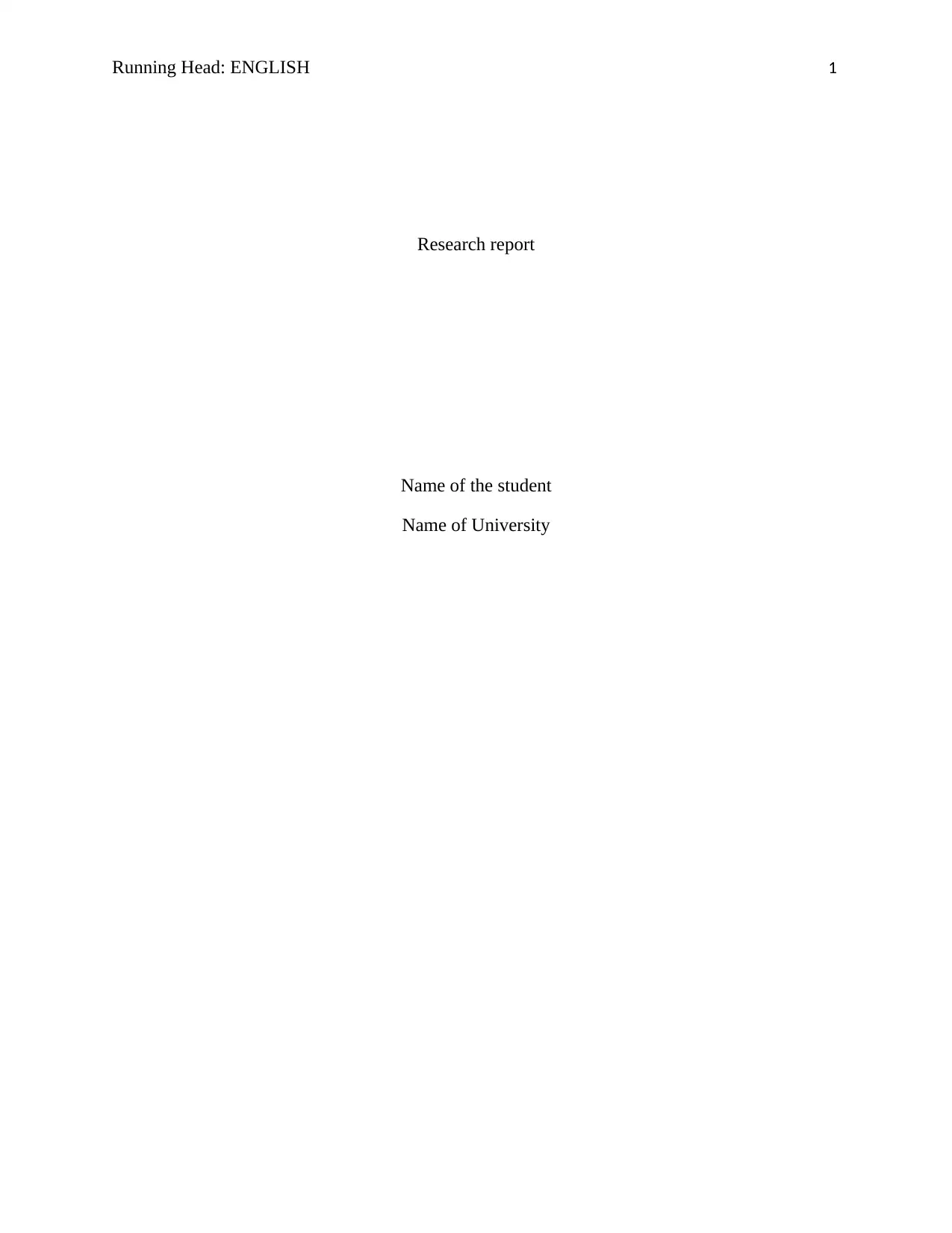
Running Head: ENGLISH 1
Research report
Name of the student
Name of University
Research report
Name of the student
Name of University
Paraphrase This Document
Need a fresh take? Get an instant paraphrase of this document with our AI Paraphraser
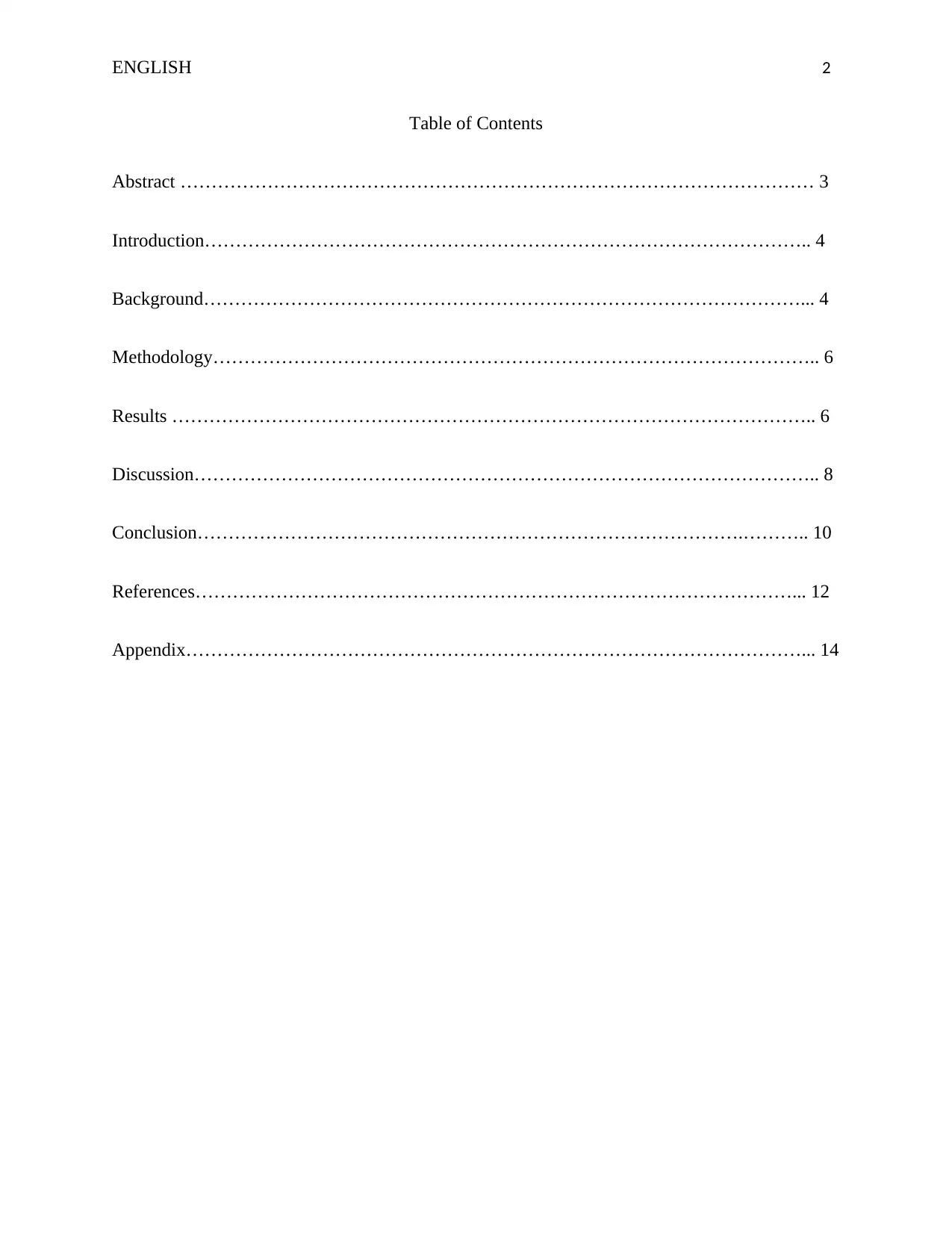
ENGLISH 2
Table of Contents
Abstract ………………………………………………………………………………………… 3
Introduction…………………………………………………………………………………….. 4
Background……………………………………………………………………………………... 4
Methodology…………………………………………………………………………………….. 6
Results ………………………………………………………………………………………….. 6
Discussion……………………………………………………………………………………….. 8
Conclusion…………………………………………………………………………….……….. 10
References……………………………………………………………………………………... 12
Appendix………………………………………………………………………………………... 14
Table of Contents
Abstract ………………………………………………………………………………………… 3
Introduction…………………………………………………………………………………….. 4
Background……………………………………………………………………………………... 4
Methodology…………………………………………………………………………………….. 6
Results ………………………………………………………………………………………….. 6
Discussion……………………………………………………………………………………….. 8
Conclusion…………………………………………………………………………….……….. 10
References……………………………………………………………………………………... 12
Appendix………………………………………………………………………………………... 14
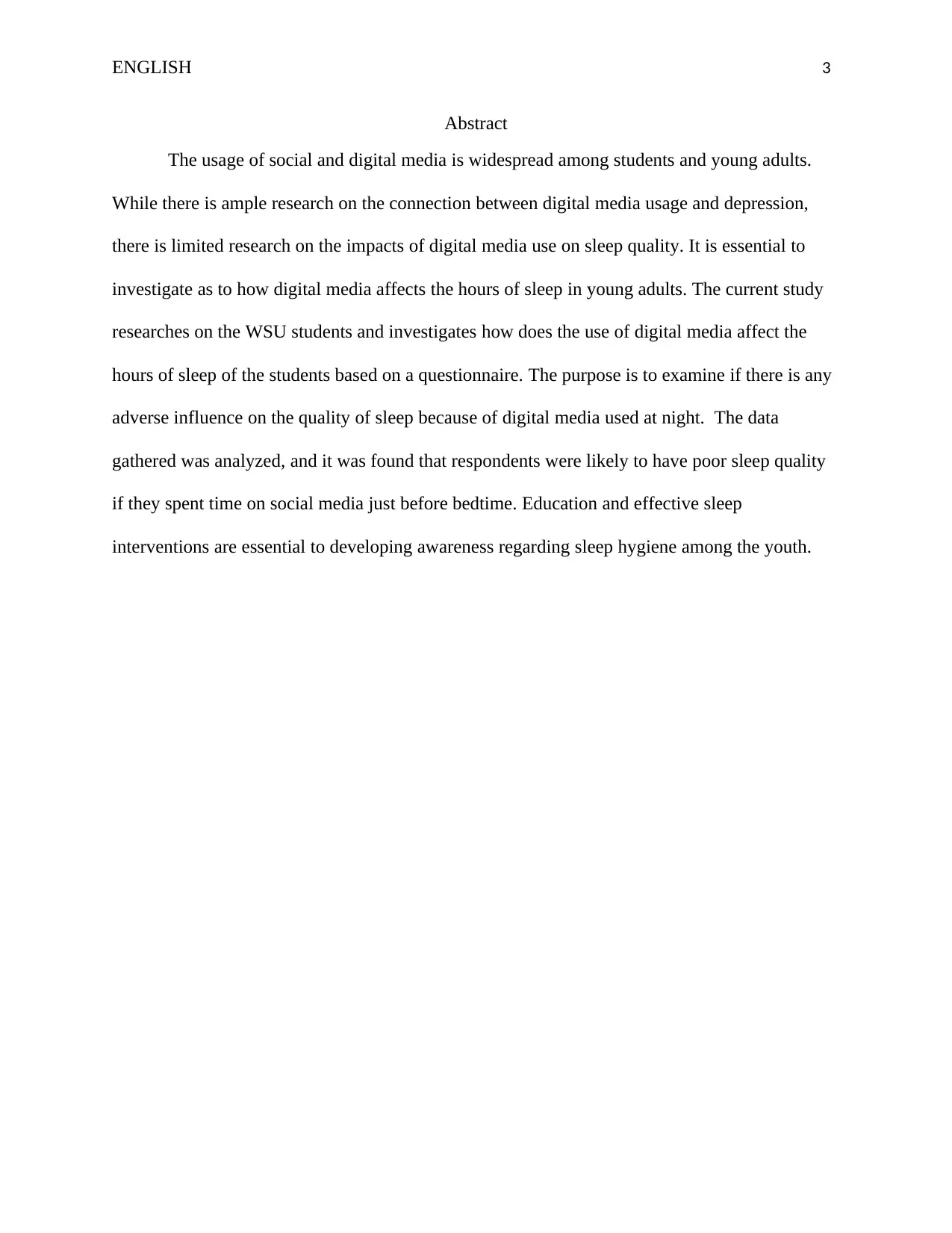
ENGLISH 3
Abstract
The usage of social and digital media is widespread among students and young adults.
While there is ample research on the connection between digital media usage and depression,
there is limited research on the impacts of digital media use on sleep quality. It is essential to
investigate as to how digital media affects the hours of sleep in young adults. The current study
researches on the WSU students and investigates how does the use of digital media affect the
hours of sleep of the students based on a questionnaire. The purpose is to examine if there is any
adverse influence on the quality of sleep because of digital media used at night. The data
gathered was analyzed, and it was found that respondents were likely to have poor sleep quality
if they spent time on social media just before bedtime. Education and effective sleep
interventions are essential to developing awareness regarding sleep hygiene among the youth.
Abstract
The usage of social and digital media is widespread among students and young adults.
While there is ample research on the connection between digital media usage and depression,
there is limited research on the impacts of digital media use on sleep quality. It is essential to
investigate as to how digital media affects the hours of sleep in young adults. The current study
researches on the WSU students and investigates how does the use of digital media affect the
hours of sleep of the students based on a questionnaire. The purpose is to examine if there is any
adverse influence on the quality of sleep because of digital media used at night. The data
gathered was analyzed, and it was found that respondents were likely to have poor sleep quality
if they spent time on social media just before bedtime. Education and effective sleep
interventions are essential to developing awareness regarding sleep hygiene among the youth.
⊘ This is a preview!⊘
Do you want full access?
Subscribe today to unlock all pages.

Trusted by 1+ million students worldwide
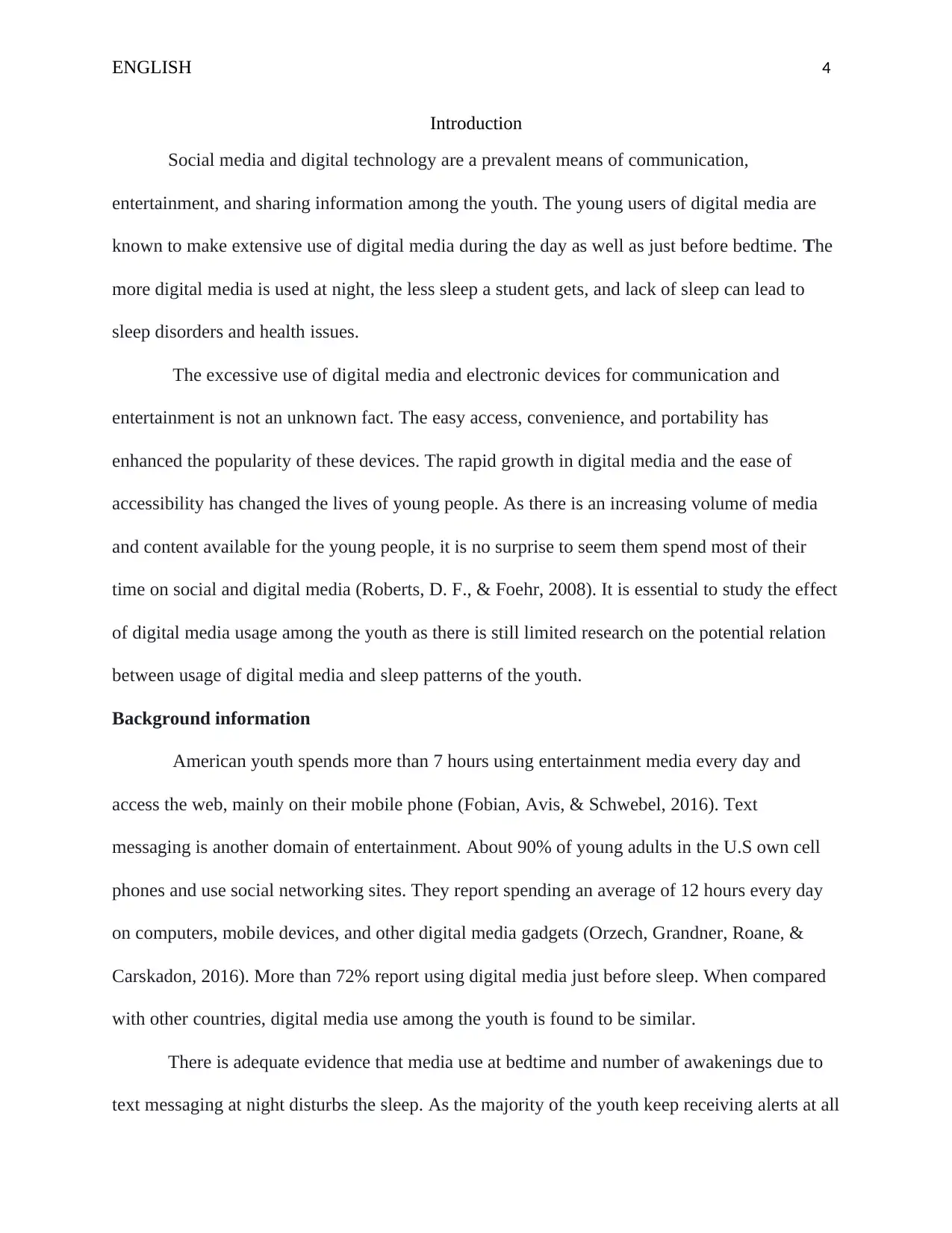
ENGLISH 4
Introduction
Social media and digital technology are a prevalent means of communication,
entertainment, and sharing information among the youth. The young users of digital media are
known to make extensive use of digital media during the day as well as just before bedtime. The
more digital media is used at night, the less sleep a student gets, and lack of sleep can lead to
sleep disorders and health issues.
The excessive use of digital media and electronic devices for communication and
entertainment is not an unknown fact. The easy access, convenience, and portability has
enhanced the popularity of these devices. The rapid growth in digital media and the ease of
accessibility has changed the lives of young people. As there is an increasing volume of media
and content available for the young people, it is no surprise to seem them spend most of their
time on social and digital media (Roberts, D. F., & Foehr, 2008). It is essential to study the effect
of digital media usage among the youth as there is still limited research on the potential relation
between usage of digital media and sleep patterns of the youth.
Background information
American youth spends more than 7 hours using entertainment media every day and
access the web, mainly on their mobile phone (Fobian, Avis, & Schwebel, 2016). Text
messaging is another domain of entertainment. About 90% of young adults in the U.S own cell
phones and use social networking sites. They report spending an average of 12 hours every day
on computers, mobile devices, and other digital media gadgets (Orzech, Grandner, Roane, &
Carskadon, 2016). More than 72% report using digital media just before sleep. When compared
with other countries, digital media use among the youth is found to be similar.
There is adequate evidence that media use at bedtime and number of awakenings due to
text messaging at night disturbs the sleep. As the majority of the youth keep receiving alerts at all
Introduction
Social media and digital technology are a prevalent means of communication,
entertainment, and sharing information among the youth. The young users of digital media are
known to make extensive use of digital media during the day as well as just before bedtime. The
more digital media is used at night, the less sleep a student gets, and lack of sleep can lead to
sleep disorders and health issues.
The excessive use of digital media and electronic devices for communication and
entertainment is not an unknown fact. The easy access, convenience, and portability has
enhanced the popularity of these devices. The rapid growth in digital media and the ease of
accessibility has changed the lives of young people. As there is an increasing volume of media
and content available for the young people, it is no surprise to seem them spend most of their
time on social and digital media (Roberts, D. F., & Foehr, 2008). It is essential to study the effect
of digital media usage among the youth as there is still limited research on the potential relation
between usage of digital media and sleep patterns of the youth.
Background information
American youth spends more than 7 hours using entertainment media every day and
access the web, mainly on their mobile phone (Fobian, Avis, & Schwebel, 2016). Text
messaging is another domain of entertainment. About 90% of young adults in the U.S own cell
phones and use social networking sites. They report spending an average of 12 hours every day
on computers, mobile devices, and other digital media gadgets (Orzech, Grandner, Roane, &
Carskadon, 2016). More than 72% report using digital media just before sleep. When compared
with other countries, digital media use among the youth is found to be similar.
There is adequate evidence that media use at bedtime and number of awakenings due to
text messaging at night disturbs the sleep. As the majority of the youth keep receiving alerts at all
Paraphrase This Document
Need a fresh take? Get an instant paraphrase of this document with our AI Paraphraser
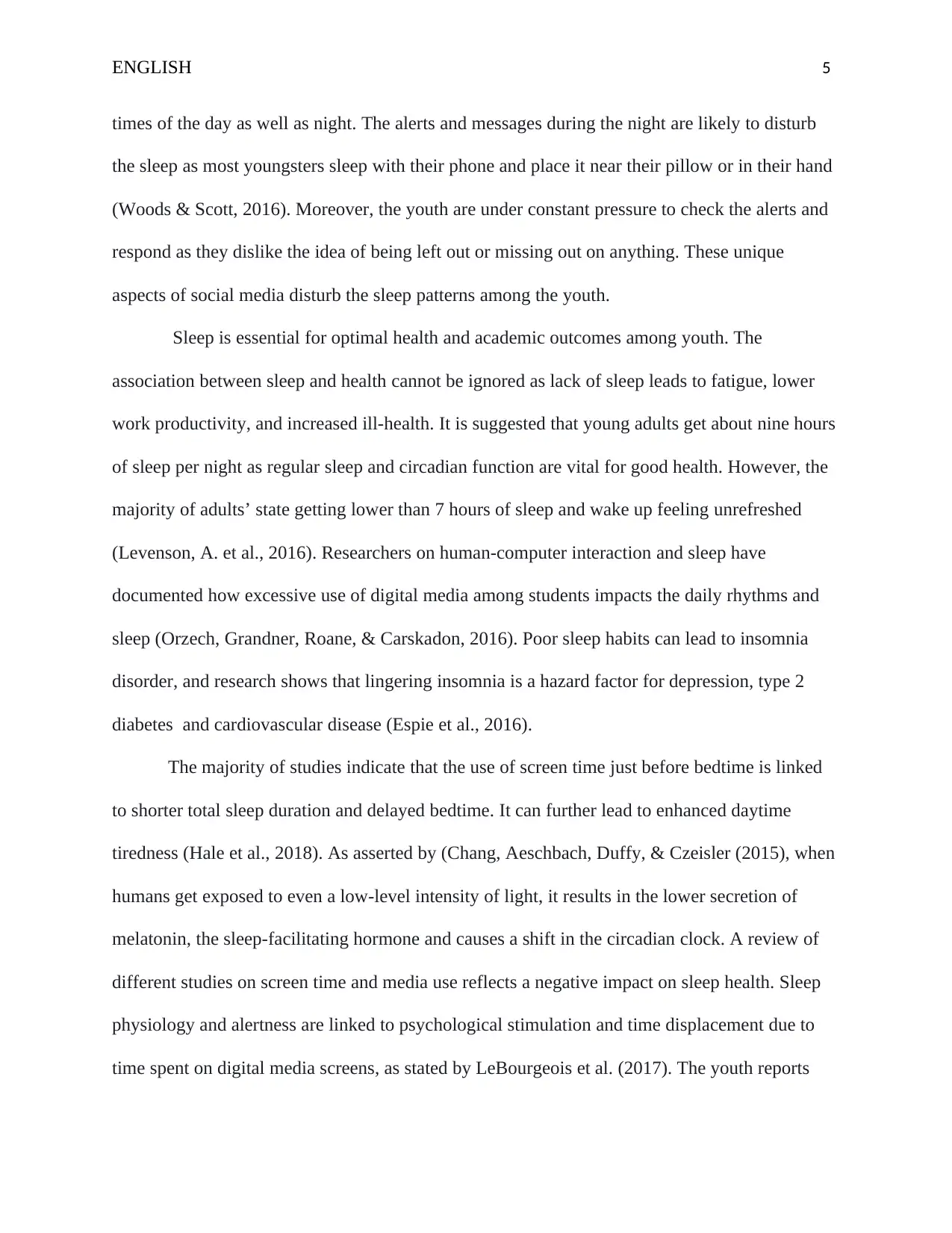
ENGLISH 5
times of the day as well as night. The alerts and messages during the night are likely to disturb
the sleep as most youngsters sleep with their phone and place it near their pillow or in their hand
(Woods & Scott, 2016). Moreover, the youth are under constant pressure to check the alerts and
respond as they dislike the idea of being left out or missing out on anything. These unique
aspects of social media disturb the sleep patterns among the youth.
Sleep is essential for optimal health and academic outcomes among youth. The
association between sleep and health cannot be ignored as lack of sleep leads to fatigue, lower
work productivity, and increased ill-health. It is suggested that young adults get about nine hours
of sleep per night as regular sleep and circadian function are vital for good health. However, the
majority of adults’ state getting lower than 7 hours of sleep and wake up feeling unrefreshed
(Levenson, A. et al., 2016). Researchers on human-computer interaction and sleep have
documented how excessive use of digital media among students impacts the daily rhythms and
sleep (Orzech, Grandner, Roane, & Carskadon, 2016). Poor sleep habits can lead to insomnia
disorder, and research shows that lingering insomnia is a hazard factor for depression, type 2
diabetes and cardiovascular disease (Espie et al., 2016).
The majority of studies indicate that the use of screen time just before bedtime is linked
to shorter total sleep duration and delayed bedtime. It can further lead to enhanced daytime
tiredness (Hale et al., 2018). As asserted by (Chang, Aeschbach, Duffy, & Czeisler (2015), when
humans get exposed to even a low-level intensity of light, it results in the lower secretion of
melatonin, the sleep-facilitating hormone and causes a shift in the circadian clock. A review of
different studies on screen time and media use reflects a negative impact on sleep health. Sleep
physiology and alertness are linked to psychological stimulation and time displacement due to
time spent on digital media screens, as stated by LeBourgeois et al. (2017). The youth reports
times of the day as well as night. The alerts and messages during the night are likely to disturb
the sleep as most youngsters sleep with their phone and place it near their pillow or in their hand
(Woods & Scott, 2016). Moreover, the youth are under constant pressure to check the alerts and
respond as they dislike the idea of being left out or missing out on anything. These unique
aspects of social media disturb the sleep patterns among the youth.
Sleep is essential for optimal health and academic outcomes among youth. The
association between sleep and health cannot be ignored as lack of sleep leads to fatigue, lower
work productivity, and increased ill-health. It is suggested that young adults get about nine hours
of sleep per night as regular sleep and circadian function are vital for good health. However, the
majority of adults’ state getting lower than 7 hours of sleep and wake up feeling unrefreshed
(Levenson, A. et al., 2016). Researchers on human-computer interaction and sleep have
documented how excessive use of digital media among students impacts the daily rhythms and
sleep (Orzech, Grandner, Roane, & Carskadon, 2016). Poor sleep habits can lead to insomnia
disorder, and research shows that lingering insomnia is a hazard factor for depression, type 2
diabetes and cardiovascular disease (Espie et al., 2016).
The majority of studies indicate that the use of screen time just before bedtime is linked
to shorter total sleep duration and delayed bedtime. It can further lead to enhanced daytime
tiredness (Hale et al., 2018). As asserted by (Chang, Aeschbach, Duffy, & Czeisler (2015), when
humans get exposed to even a low-level intensity of light, it results in the lower secretion of
melatonin, the sleep-facilitating hormone and causes a shift in the circadian clock. A review of
different studies on screen time and media use reflects a negative impact on sleep health. Sleep
physiology and alertness are linked to psychological stimulation and time displacement due to
time spent on digital media screens, as stated by LeBourgeois et al. (2017). The youth reports
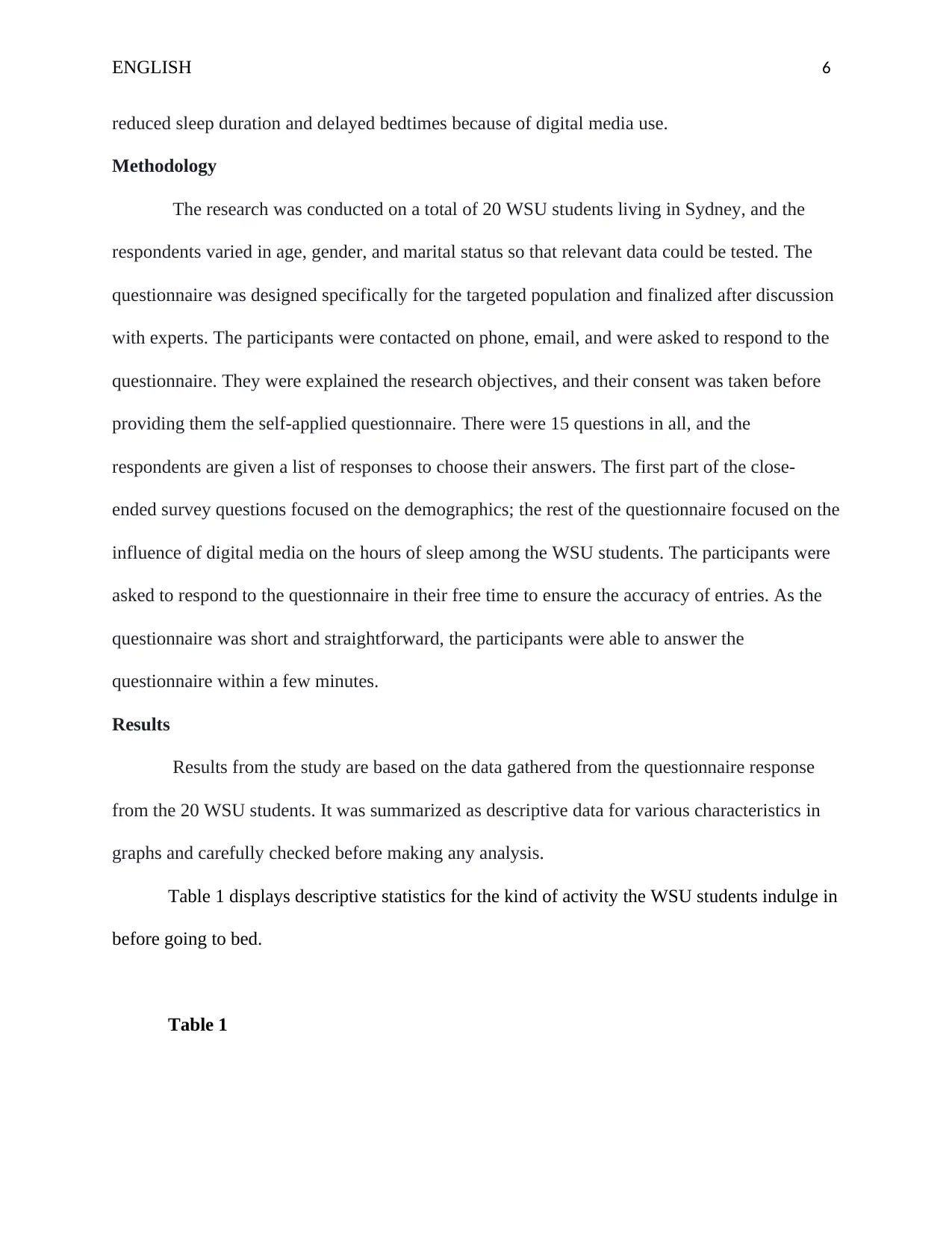
ENGLISH 6
reduced sleep duration and delayed bedtimes because of digital media use.
Methodology
The research was conducted on a total of 20 WSU students living in Sydney, and the
respondents varied in age, gender, and marital status so that relevant data could be tested. The
questionnaire was designed specifically for the targeted population and finalized after discussion
with experts. The participants were contacted on phone, email, and were asked to respond to the
questionnaire. They were explained the research objectives, and their consent was taken before
providing them the self-applied questionnaire. There were 15 questions in all, and the
respondents are given a list of responses to choose their answers. The first part of the close-
ended survey questions focused on the demographics; the rest of the questionnaire focused on the
influence of digital media on the hours of sleep among the WSU students. The participants were
asked to respond to the questionnaire in their free time to ensure the accuracy of entries. As the
questionnaire was short and straightforward, the participants were able to answer the
questionnaire within a few minutes.
Results
Results from the study are based on the data gathered from the questionnaire response
from the 20 WSU students. It was summarized as descriptive data for various characteristics in
graphs and carefully checked before making any analysis.
Table 1 displays descriptive statistics for the kind of activity the WSU students indulge in
before going to bed.
Table 1
reduced sleep duration and delayed bedtimes because of digital media use.
Methodology
The research was conducted on a total of 20 WSU students living in Sydney, and the
respondents varied in age, gender, and marital status so that relevant data could be tested. The
questionnaire was designed specifically for the targeted population and finalized after discussion
with experts. The participants were contacted on phone, email, and were asked to respond to the
questionnaire. They were explained the research objectives, and their consent was taken before
providing them the self-applied questionnaire. There were 15 questions in all, and the
respondents are given a list of responses to choose their answers. The first part of the close-
ended survey questions focused on the demographics; the rest of the questionnaire focused on the
influence of digital media on the hours of sleep among the WSU students. The participants were
asked to respond to the questionnaire in their free time to ensure the accuracy of entries. As the
questionnaire was short and straightforward, the participants were able to answer the
questionnaire within a few minutes.
Results
Results from the study are based on the data gathered from the questionnaire response
from the 20 WSU students. It was summarized as descriptive data for various characteristics in
graphs and carefully checked before making any analysis.
Table 1 displays descriptive statistics for the kind of activity the WSU students indulge in
before going to bed.
Table 1
⊘ This is a preview!⊘
Do you want full access?
Subscribe today to unlock all pages.

Trusted by 1+ million students worldwide
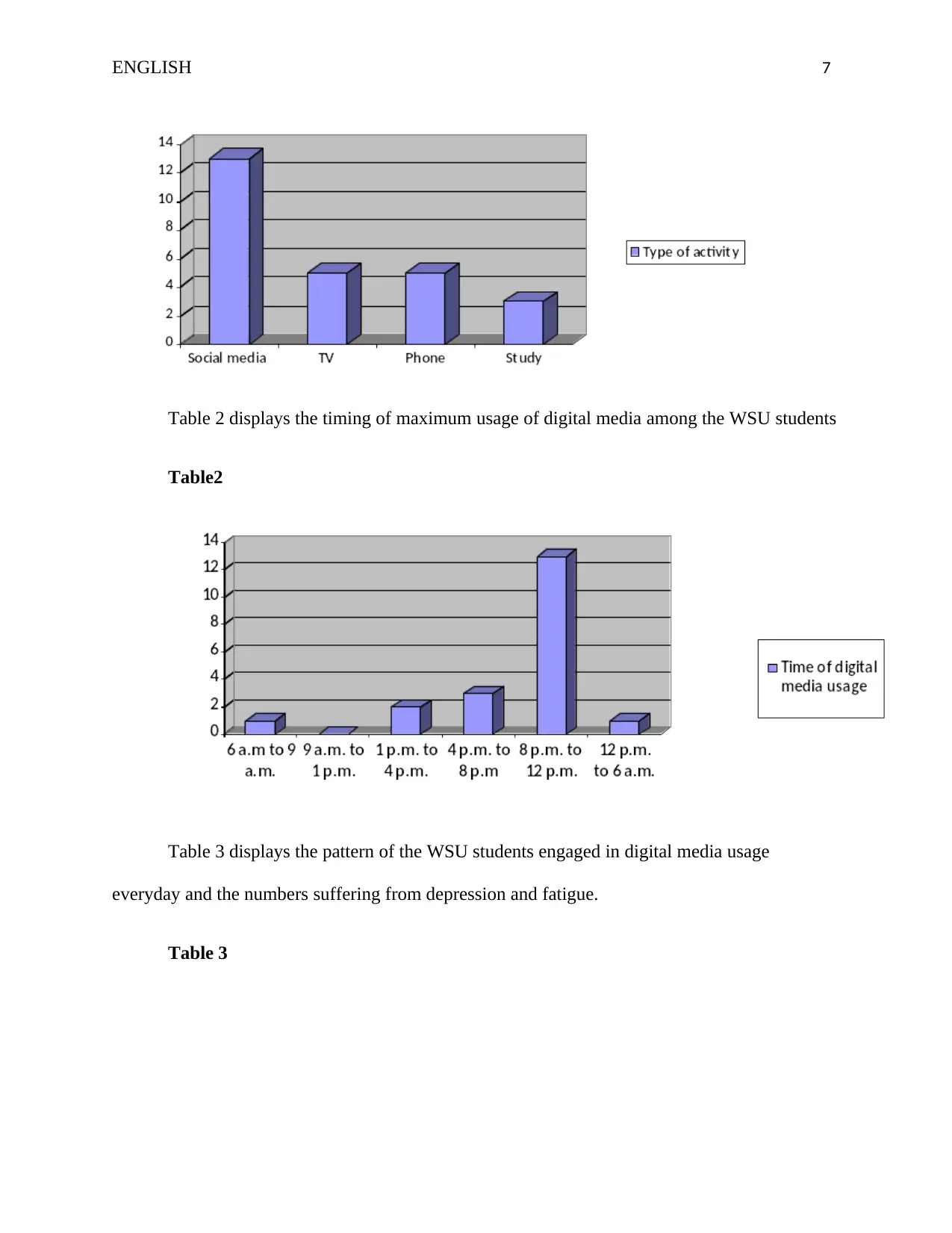
ENGLISH 7
Table 2 displays the timing of maximum usage of digital media among the WSU students
Table2
Table 3 displays the pattern of the WSU students engaged in digital media usage
everyday and the numbers suffering from depression and fatigue.
Table 3
Table 2 displays the timing of maximum usage of digital media among the WSU students
Table2
Table 3 displays the pattern of the WSU students engaged in digital media usage
everyday and the numbers suffering from depression and fatigue.
Table 3
Paraphrase This Document
Need a fresh take? Get an instant paraphrase of this document with our AI Paraphraser
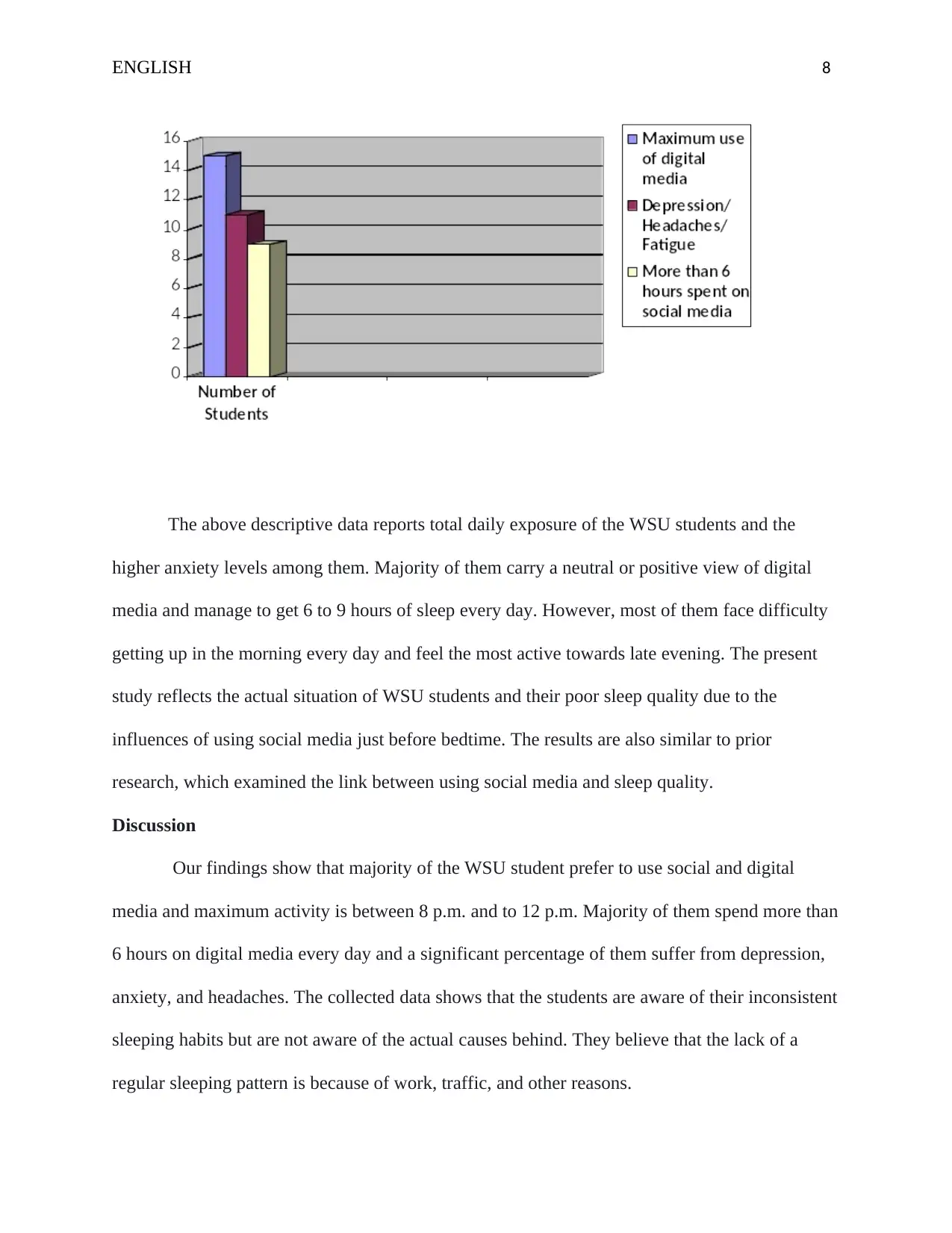
ENGLISH 8
The above descriptive data reports total daily exposure of the WSU students and the
higher anxiety levels among them. Majority of them carry a neutral or positive view of digital
media and manage to get 6 to 9 hours of sleep every day. However, most of them face difficulty
getting up in the morning every day and feel the most active towards late evening. The present
study reflects the actual situation of WSU students and their poor sleep quality due to the
influences of using social media just before bedtime. The results are also similar to prior
research, which examined the link between using social media and sleep quality.
Discussion
Our findings show that majority of the WSU student prefer to use social and digital
media and maximum activity is between 8 p.m. and to 12 p.m. Majority of them spend more than
6 hours on digital media every day and a significant percentage of them suffer from depression,
anxiety, and headaches. The collected data shows that the students are aware of their inconsistent
sleeping habits but are not aware of the actual causes behind. They believe that the lack of a
regular sleeping pattern is because of work, traffic, and other reasons.
The above descriptive data reports total daily exposure of the WSU students and the
higher anxiety levels among them. Majority of them carry a neutral or positive view of digital
media and manage to get 6 to 9 hours of sleep every day. However, most of them face difficulty
getting up in the morning every day and feel the most active towards late evening. The present
study reflects the actual situation of WSU students and their poor sleep quality due to the
influences of using social media just before bedtime. The results are also similar to prior
research, which examined the link between using social media and sleep quality.
Discussion
Our findings show that majority of the WSU student prefer to use social and digital
media and maximum activity is between 8 p.m. and to 12 p.m. Majority of them spend more than
6 hours on digital media every day and a significant percentage of them suffer from depression,
anxiety, and headaches. The collected data shows that the students are aware of their inconsistent
sleeping habits but are not aware of the actual causes behind. They believe that the lack of a
regular sleeping pattern is because of work, traffic, and other reasons.
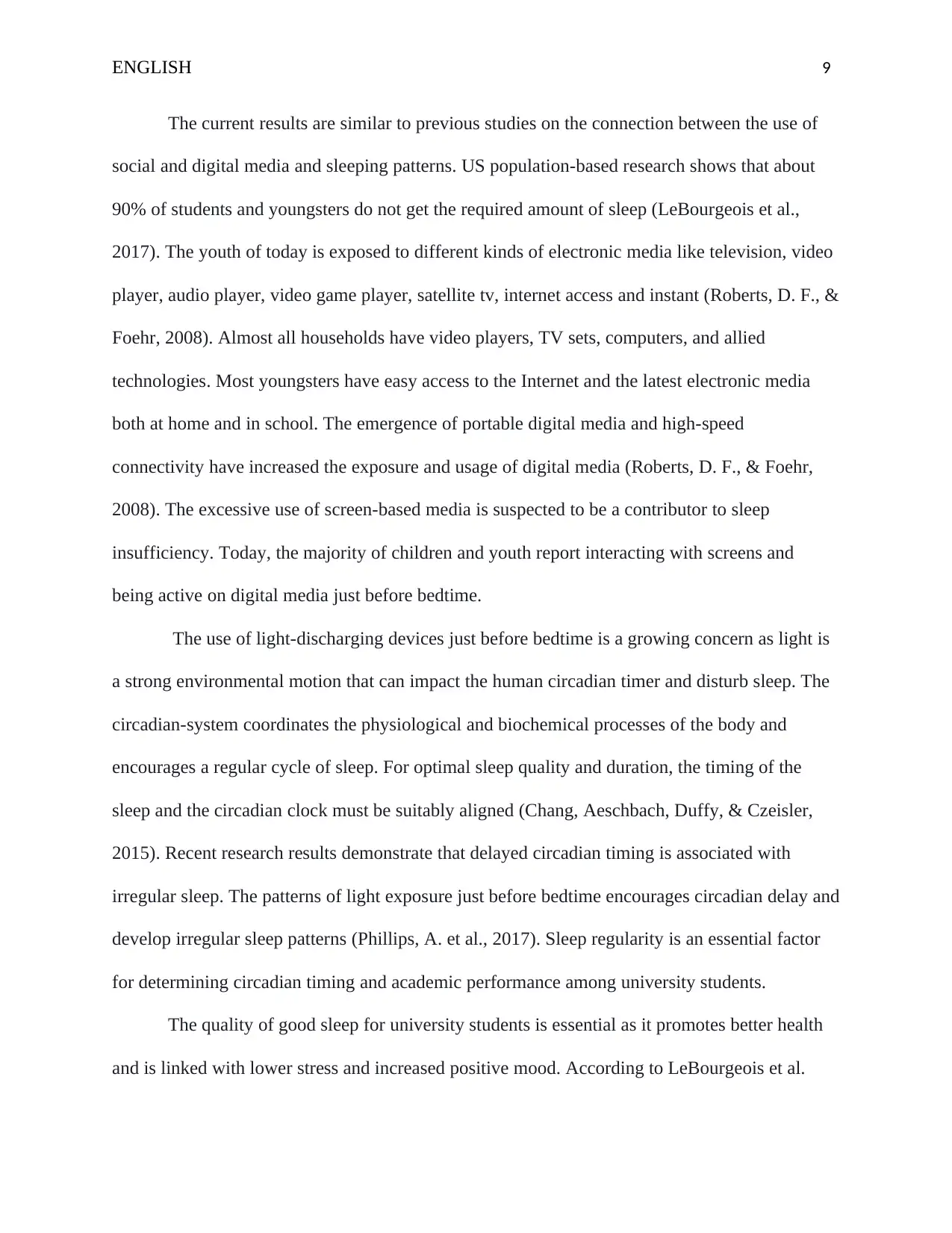
ENGLISH 9
The current results are similar to previous studies on the connection between the use of
social and digital media and sleeping patterns. US population-based research shows that about
90% of students and youngsters do not get the required amount of sleep (LeBourgeois et al.,
2017). The youth of today is exposed to different kinds of electronic media like television, video
player, audio player, video game player, satellite tv, internet access and instant (Roberts, D. F., &
Foehr, 2008). Almost all households have video players, TV sets, computers, and allied
technologies. Most youngsters have easy access to the Internet and the latest electronic media
both at home and in school. The emergence of portable digital media and high-speed
connectivity have increased the exposure and usage of digital media (Roberts, D. F., & Foehr,
2008). The excessive use of screen-based media is suspected to be a contributor to sleep
insufficiency. Today, the majority of children and youth report interacting with screens and
being active on digital media just before bedtime.
The use of light-discharging devices just before bedtime is a growing concern as light is
a strong environmental motion that can impact the human circadian timer and disturb sleep. The
circadian-system coordinates the physiological and biochemical processes of the body and
encourages a regular cycle of sleep. For optimal sleep quality and duration, the timing of the
sleep and the circadian clock must be suitably aligned (Chang, Aeschbach, Duffy, & Czeisler,
2015). Recent research results demonstrate that delayed circadian timing is associated with
irregular sleep. The patterns of light exposure just before bedtime encourages circadian delay and
develop irregular sleep patterns (Phillips, A. et al., 2017). Sleep regularity is an essential factor
for determining circadian timing and academic performance among university students.
The quality of good sleep for university students is essential as it promotes better health
and is linked with lower stress and increased positive mood. According to LeBourgeois et al.
The current results are similar to previous studies on the connection between the use of
social and digital media and sleeping patterns. US population-based research shows that about
90% of students and youngsters do not get the required amount of sleep (LeBourgeois et al.,
2017). The youth of today is exposed to different kinds of electronic media like television, video
player, audio player, video game player, satellite tv, internet access and instant (Roberts, D. F., &
Foehr, 2008). Almost all households have video players, TV sets, computers, and allied
technologies. Most youngsters have easy access to the Internet and the latest electronic media
both at home and in school. The emergence of portable digital media and high-speed
connectivity have increased the exposure and usage of digital media (Roberts, D. F., & Foehr,
2008). The excessive use of screen-based media is suspected to be a contributor to sleep
insufficiency. Today, the majority of children and youth report interacting with screens and
being active on digital media just before bedtime.
The use of light-discharging devices just before bedtime is a growing concern as light is
a strong environmental motion that can impact the human circadian timer and disturb sleep. The
circadian-system coordinates the physiological and biochemical processes of the body and
encourages a regular cycle of sleep. For optimal sleep quality and duration, the timing of the
sleep and the circadian clock must be suitably aligned (Chang, Aeschbach, Duffy, & Czeisler,
2015). Recent research results demonstrate that delayed circadian timing is associated with
irregular sleep. The patterns of light exposure just before bedtime encourages circadian delay and
develop irregular sleep patterns (Phillips, A. et al., 2017). Sleep regularity is an essential factor
for determining circadian timing and academic performance among university students.
The quality of good sleep for university students is essential as it promotes better health
and is linked with lower stress and increased positive mood. According to LeBourgeois et al.
⊘ This is a preview!⊘
Do you want full access?
Subscribe today to unlock all pages.

Trusted by 1+ million students worldwide
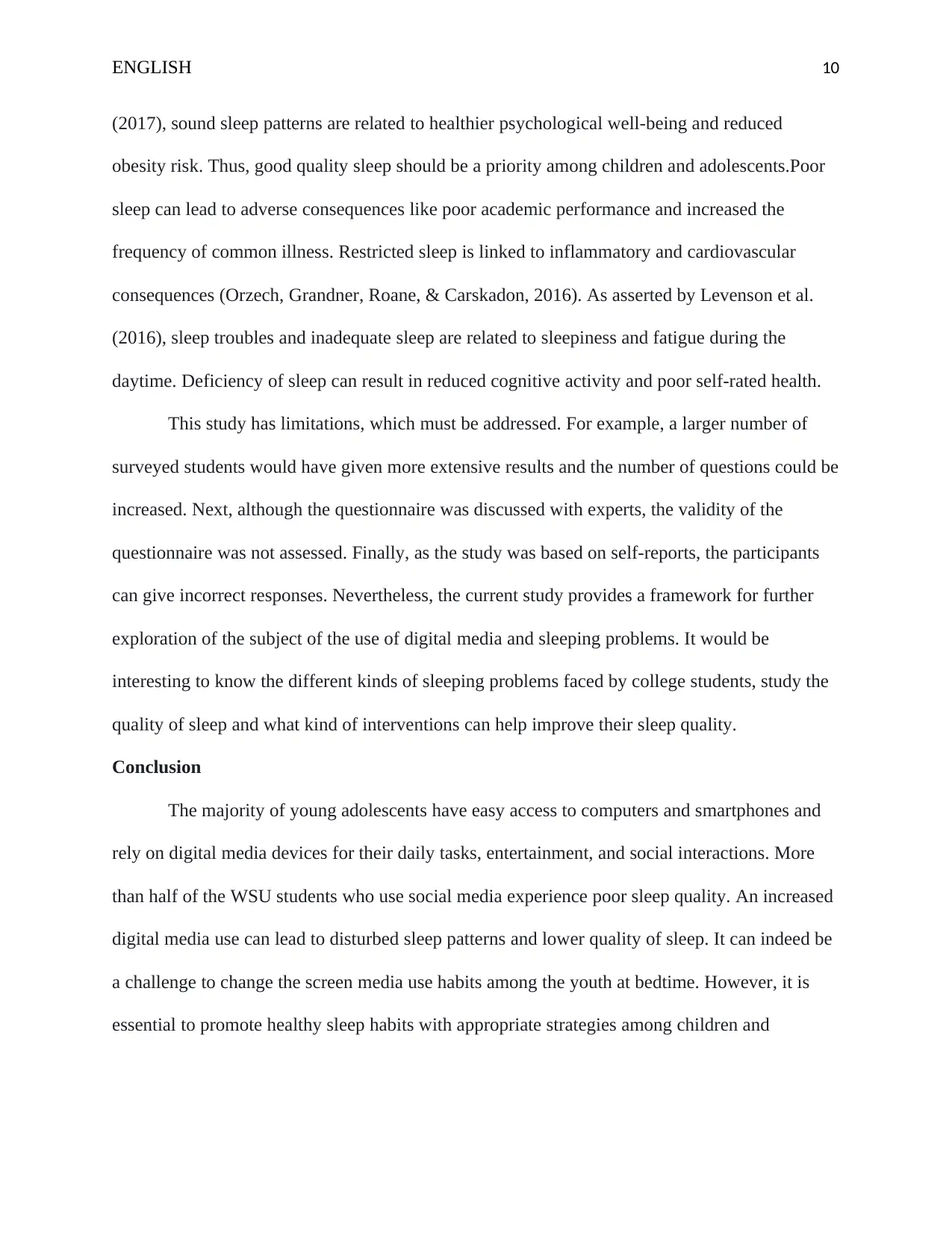
ENGLISH 10
(2017), sound sleep patterns are related to healthier psychological well-being and reduced
obesity risk. Thus, good quality sleep should be a priority among children and adolescents.Poor
sleep can lead to adverse consequences like poor academic performance and increased the
frequency of common illness. Restricted sleep is linked to inflammatory and cardiovascular
consequences (Orzech, Grandner, Roane, & Carskadon, 2016). As asserted by Levenson et al.
(2016), sleep troubles and inadequate sleep are related to sleepiness and fatigue during the
daytime. Deficiency of sleep can result in reduced cognitive activity and poor self-rated health.
This study has limitations, which must be addressed. For example, a larger number of
surveyed students would have given more extensive results and the number of questions could be
increased. Next, although the questionnaire was discussed with experts, the validity of the
questionnaire was not assessed. Finally, as the study was based on self-reports, the participants
can give incorrect responses. Nevertheless, the current study provides a framework for further
exploration of the subject of the use of digital media and sleeping problems. It would be
interesting to know the different kinds of sleeping problems faced by college students, study the
quality of sleep and what kind of interventions can help improve their sleep quality.
Conclusion
The majority of young adolescents have easy access to computers and smartphones and
rely on digital media devices for their daily tasks, entertainment, and social interactions. More
than half of the WSU students who use social media experience poor sleep quality. An increased
digital media use can lead to disturbed sleep patterns and lower quality of sleep. It can indeed be
a challenge to change the screen media use habits among the youth at bedtime. However, it is
essential to promote healthy sleep habits with appropriate strategies among children and
(2017), sound sleep patterns are related to healthier psychological well-being and reduced
obesity risk. Thus, good quality sleep should be a priority among children and adolescents.Poor
sleep can lead to adverse consequences like poor academic performance and increased the
frequency of common illness. Restricted sleep is linked to inflammatory and cardiovascular
consequences (Orzech, Grandner, Roane, & Carskadon, 2016). As asserted by Levenson et al.
(2016), sleep troubles and inadequate sleep are related to sleepiness and fatigue during the
daytime. Deficiency of sleep can result in reduced cognitive activity and poor self-rated health.
This study has limitations, which must be addressed. For example, a larger number of
surveyed students would have given more extensive results and the number of questions could be
increased. Next, although the questionnaire was discussed with experts, the validity of the
questionnaire was not assessed. Finally, as the study was based on self-reports, the participants
can give incorrect responses. Nevertheless, the current study provides a framework for further
exploration of the subject of the use of digital media and sleeping problems. It would be
interesting to know the different kinds of sleeping problems faced by college students, study the
quality of sleep and what kind of interventions can help improve their sleep quality.
Conclusion
The majority of young adolescents have easy access to computers and smartphones and
rely on digital media devices for their daily tasks, entertainment, and social interactions. More
than half of the WSU students who use social media experience poor sleep quality. An increased
digital media use can lead to disturbed sleep patterns and lower quality of sleep. It can indeed be
a challenge to change the screen media use habits among the youth at bedtime. However, it is
essential to promote healthy sleep habits with appropriate strategies among children and
Paraphrase This Document
Need a fresh take? Get an instant paraphrase of this document with our AI Paraphraser
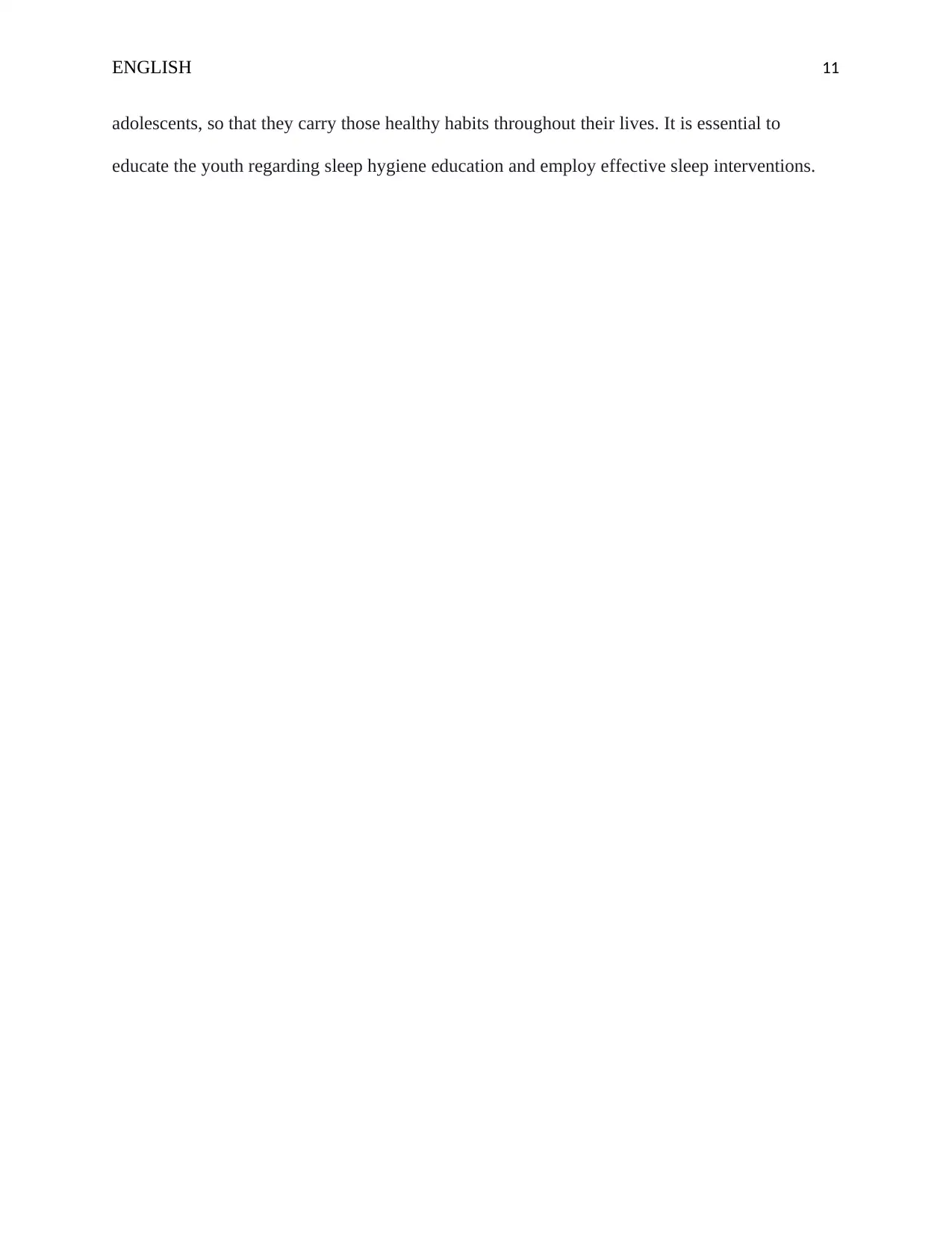
ENGLISH 11
adolescents, so that they carry those healthy habits throughout their lives. It is essential to
educate the youth regarding sleep hygiene education and employ effective sleep interventions.
adolescents, so that they carry those healthy habits throughout their lives. It is essential to
educate the youth regarding sleep hygiene education and employ effective sleep interventions.
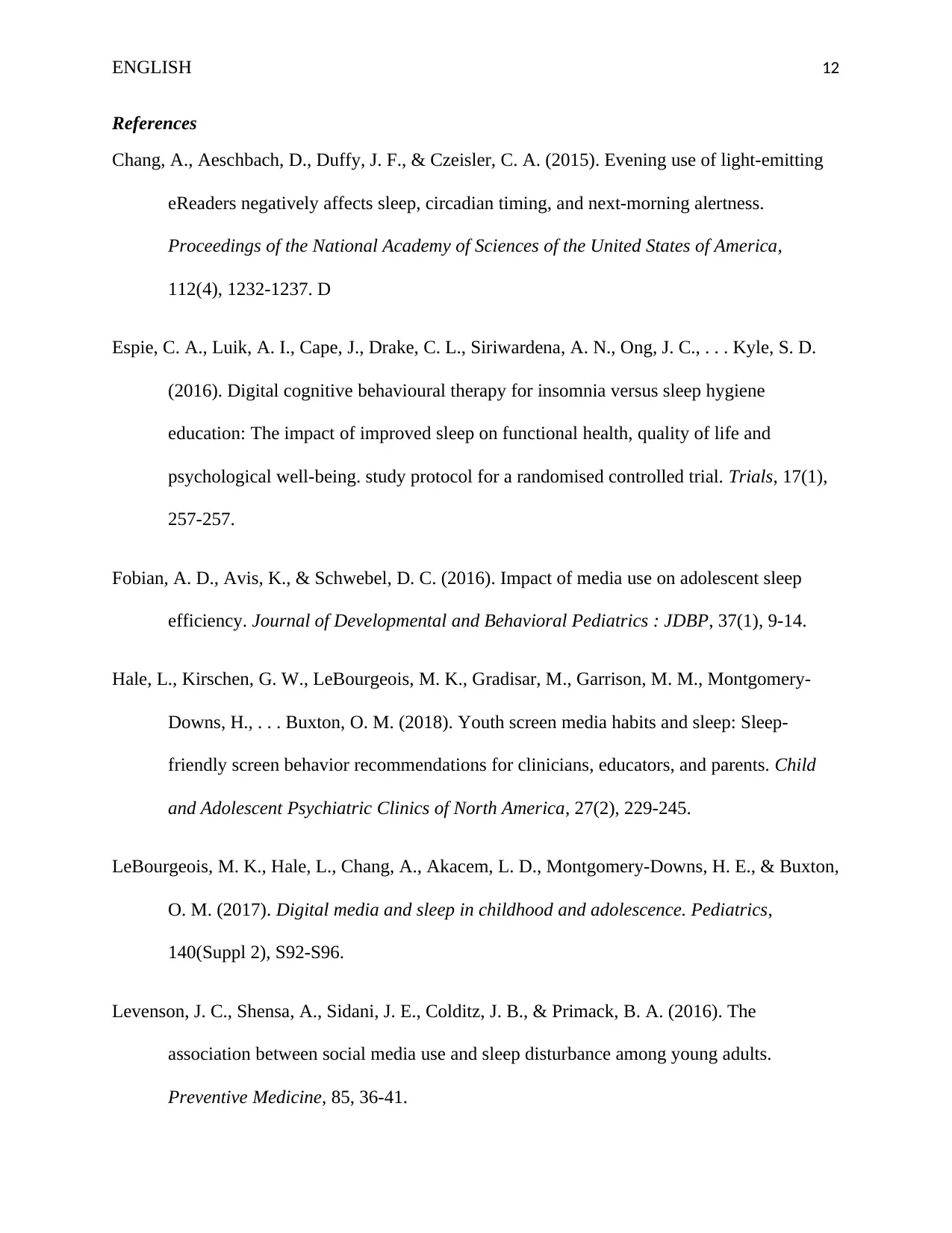
ENGLISH 12
References
Chang, A., Aeschbach, D., Duffy, J. F., & Czeisler, C. A. (2015). Evening use of light-emitting
eReaders negatively affects sleep, circadian timing, and next-morning alertness.
Proceedings of the National Academy of Sciences of the United States of America,
112(4), 1232-1237. D
Espie, C. A., Luik, A. I., Cape, J., Drake, C. L., Siriwardena, A. N., Ong, J. C., . . . Kyle, S. D.
(2016). Digital cognitive behavioural therapy for insomnia versus sleep hygiene
education: The impact of improved sleep on functional health, quality of life and
psychological well-being. study protocol for a randomised controlled trial. Trials, 17(1),
257-257.
Fobian, A. D., Avis, K., & Schwebel, D. C. (2016). Impact of media use on adolescent sleep
efficiency. Journal of Developmental and Behavioral Pediatrics : JDBP, 37(1), 9-14.
Hale, L., Kirschen, G. W., LeBourgeois, M. K., Gradisar, M., Garrison, M. M., Montgomery-
Downs, H., . . . Buxton, O. M. (2018). Youth screen media habits and sleep: Sleep-
friendly screen behavior recommendations for clinicians, educators, and parents. Child
and Adolescent Psychiatric Clinics of North America, 27(2), 229-245.
LeBourgeois, M. K., Hale, L., Chang, A., Akacem, L. D., Montgomery-Downs, H. E., & Buxton,
O. M. (2017). Digital media and sleep in childhood and adolescence. Pediatrics,
140(Suppl 2), S92-S96.
Levenson, J. C., Shensa, A., Sidani, J. E., Colditz, J. B., & Primack, B. A. (2016). The
association between social media use and sleep disturbance among young adults.
Preventive Medicine, 85, 36-41.
References
Chang, A., Aeschbach, D., Duffy, J. F., & Czeisler, C. A. (2015). Evening use of light-emitting
eReaders negatively affects sleep, circadian timing, and next-morning alertness.
Proceedings of the National Academy of Sciences of the United States of America,
112(4), 1232-1237. D
Espie, C. A., Luik, A. I., Cape, J., Drake, C. L., Siriwardena, A. N., Ong, J. C., . . . Kyle, S. D.
(2016). Digital cognitive behavioural therapy for insomnia versus sleep hygiene
education: The impact of improved sleep on functional health, quality of life and
psychological well-being. study protocol for a randomised controlled trial. Trials, 17(1),
257-257.
Fobian, A. D., Avis, K., & Schwebel, D. C. (2016). Impact of media use on adolescent sleep
efficiency. Journal of Developmental and Behavioral Pediatrics : JDBP, 37(1), 9-14.
Hale, L., Kirschen, G. W., LeBourgeois, M. K., Gradisar, M., Garrison, M. M., Montgomery-
Downs, H., . . . Buxton, O. M. (2018). Youth screen media habits and sleep: Sleep-
friendly screen behavior recommendations for clinicians, educators, and parents. Child
and Adolescent Psychiatric Clinics of North America, 27(2), 229-245.
LeBourgeois, M. K., Hale, L., Chang, A., Akacem, L. D., Montgomery-Downs, H. E., & Buxton,
O. M. (2017). Digital media and sleep in childhood and adolescence. Pediatrics,
140(Suppl 2), S92-S96.
Levenson, J. C., Shensa, A., Sidani, J. E., Colditz, J. B., & Primack, B. A. (2016). The
association between social media use and sleep disturbance among young adults.
Preventive Medicine, 85, 36-41.
⊘ This is a preview!⊘
Do you want full access?
Subscribe today to unlock all pages.

Trusted by 1+ million students worldwide
1 out of 17
Related Documents
Your All-in-One AI-Powered Toolkit for Academic Success.
+13062052269
info@desklib.com
Available 24*7 on WhatsApp / Email
![[object Object]](/_next/static/media/star-bottom.7253800d.svg)
Unlock your academic potential
Copyright © 2020–2025 A2Z Services. All Rights Reserved. Developed and managed by ZUCOL.




